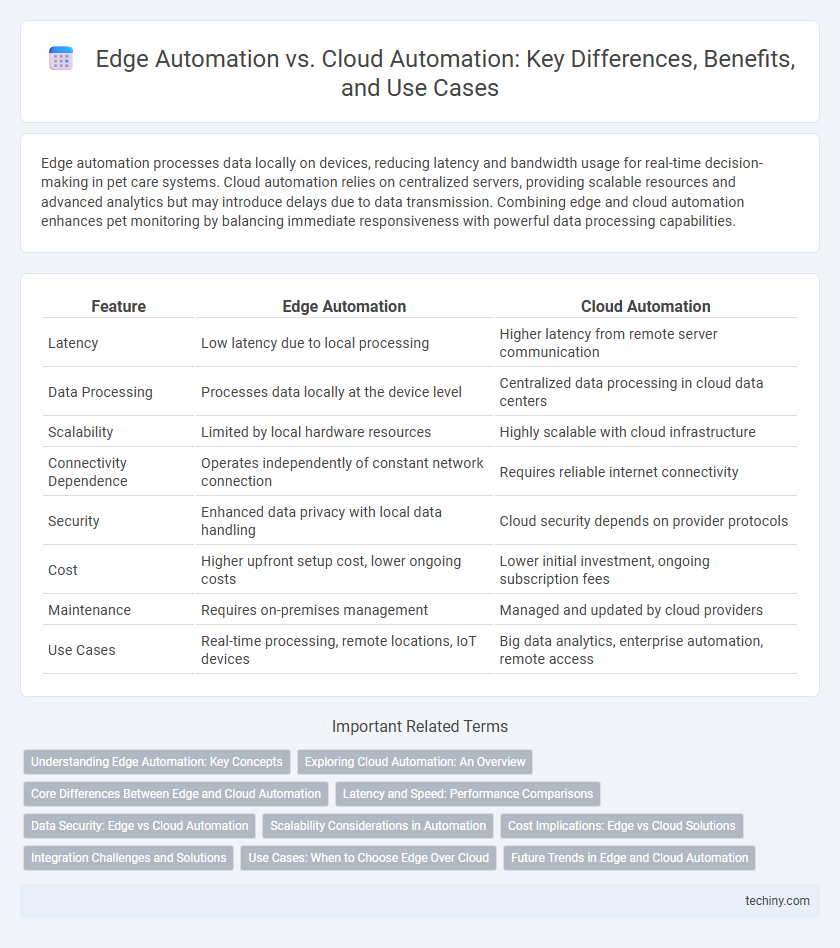Edge automation processes data locally on devices, reducing latency and bandwidth usage for real-time decision-making in pet care systems. Cloud automation relies on centralized servers, providing scalable resources and advanced analytics but may introduce delays due to data transmission. Combining edge and cloud automation enhances pet monitoring by balancing immediate responsiveness with powerful data processing capabilities.
Table of Comparison
| Feature | Edge Automation | Cloud Automation |
|---|---|---|
| Latency | Low latency due to local processing | Higher latency from remote server communication |
| Data Processing | Processes data locally at the device level | Centralized data processing in cloud data centers |
| Scalability | Limited by local hardware resources | Highly scalable with cloud infrastructure |
| Connectivity Dependence | Operates independently of constant network connection | Requires reliable internet connectivity |
| Security | Enhanced data privacy with local data handling | Cloud security depends on provider protocols |
| Cost | Higher upfront setup cost, lower ongoing costs | Lower initial investment, ongoing subscription fees |
| Maintenance | Requires on-premises management | Managed and updated by cloud providers |
| Use Cases | Real-time processing, remote locations, IoT devices | Big data analytics, enterprise automation, remote access |
Understanding Edge Automation: Key Concepts
Edge automation involves processing data closer to the source of generation, reducing latency and bandwidth usage compared to cloud automation, which relies on centralized data centers. Key concepts include real-time data processing, decentralized computing, and enhanced security due to localized control. This approach optimizes performance for applications requiring immediate decision-making and minimizes reliance on continuous cloud connectivity.
Exploring Cloud Automation: An Overview
Cloud automation leverages centralized data centers to streamline IT processes, enabling scalable resource management and rapid deployment of applications. It enhances operational efficiency by automating tasks such as provisioning, configuration, and monitoring across diverse cloud environments. This approach supports continuous integration and continuous delivery (CI/CD), facilitating agile software development and minimizing manual intervention.
Core Differences Between Edge and Cloud Automation
Edge automation processes data locally on devices or edge servers, minimizing latency and enhancing real-time decision-making capabilities. Cloud automation centralizes data processing and management in remote data centers, offering scalability and extensive resource availability but potentially increasing response times. The core difference lies in edge automation's emphasis on proximity to data sources for immediate actions, while cloud automation relies on centralized infrastructure for complex computing and broader integration.
Latency and Speed: Performance Comparisons
Edge automation significantly reduces latency by processing data locally, enabling real-time decision-making and faster response times compared to cloud automation. Cloud automation relies on centralized data centers, introducing higher latency due to data transmission delays, which can impact time-sensitive applications. For performance-critical tasks such as industrial control or autonomous vehicles, edge automation delivers superior speed and reliability by minimizing communication overhead.
Data Security: Edge vs Cloud Automation
Edge automation enhances data security by processing information locally on devices, reducing exposure to cyber threats inherent in cloud data transmission. Cloud automation depends on centralized servers, increasing the risk of data breaches during transfer and storage but benefits from robust, continuously updated security protocols. Choosing between edge and cloud automation for data security involves balancing local control and latency reduction against the comprehensive protection and scalability offered by cloud services.
Scalability Considerations in Automation
Edge automation enhances scalability by processing data locally, reducing latency and bandwidth usage, which is ideal for real-time applications and IoT devices. Cloud automation offers virtually unlimited scalability by leveraging centralized resources, enabling extensive data analytics and orchestration across distributed environments. Balancing edge and cloud automation optimizes scalability by combining local processing speed with the cloud's computational power.
Cost Implications: Edge vs Cloud Solutions
Edge automation reduces operational costs by minimizing data transfer and latency, enabling real-time processing closer to data sources. Cloud automation often incurs higher ongoing expenses due to bandwidth usage, storage fees, and centralized infrastructure maintenance. Companies must evaluate workloads and data sensitivity to balance cost-effectiveness between edge and cloud automation solutions.
Integration Challenges and Solutions
Edge automation faces integration challenges such as limited bandwidth, latency sensitivity, and device heterogeneity, complicating seamless data synchronization with cloud environments. Cloud automation struggles with latency and security concerns when managing distributed edge devices, necessitating hybrid frameworks that balance local processing and centralized control. Solutions involve adopting standardized communication protocols like MQTT, implementing edge gateways for data preprocessing, and leveraging AI-driven orchestration to optimize resource allocation across edge and cloud systems.
Use Cases: When to Choose Edge Over Cloud
Edge automation excels in scenarios requiring ultra-low latency and real-time processing, such as autonomous vehicles, industrial robotics, and smart grid management. Cloud automation is less effective for applications with intermittent connectivity or strict data privacy needs, making edge solutions critical for remote sites or sensitive data environments. Organizations prioritize edge automation when immediate decision-making and local data processing outweigh centralized cloud benefits.
Future Trends in Edge and Cloud Automation
Edge automation is rapidly advancing with the integration of AI-powered IoT devices, enabling real-time data processing and decision-making at the source, which reduces latency and bandwidth usage. Cloud automation continues to evolve through enhanced AI-driven orchestration, scalable microservices, and robust security frameworks, facilitating complex workflow automation and centralized data analytics. Future trends highlight a hybrid approach combining edge and cloud automation, leveraging edge for immediate processing and cloud for large-scale data analysis, optimizing performance and operational efficiency across industries.
Edge Automation vs Cloud Automation Infographic

 techiny.com
techiny.com